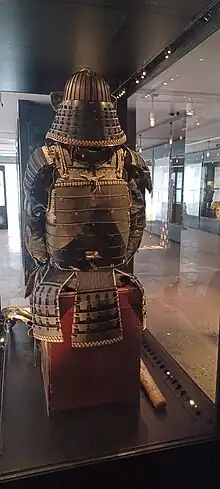Östasiatiska museet | |
 Museum of Far Eastern Antiquities | |
| Established | 1926 |
|---|---|
| Location | Stockholm, Sweden |
| Coordinates | 59°19′37″N 18°04′55″E / 59.327°N 18.082°E |
| Website | www |
The Museum of Far Eastern Antiquities (Swedish: Östasiatiska museet), located in Stockholm, Sweden, is a museum launched by Sweden's Parliament in 1926, with the Swedish archaeologist Johan Gunnar Andersson (1874–1960) as founding director. The museum is located on Skeppsholmen in the building Tyghuset and since 1999 the museum is a part of the public Swedish National Museums of World Culture.
Overview
The museum was originally based mainly on Andersson's groundbreaking discoveries in China, during the 1920s, of a hitherto unknown East Asian prehistory. The museum today has wide-ranging collections from Japan, Korea, India and China. It exhibits of both archeology, classical arts and contemporary culture, and holds a large research library open to the public. The last time the museum published a comprehensive catalog was 1963 (Museum of Far Eastern Antiquities: Album). The museum also publishes an annual journal focused on research on ancient East Asia, the Bulletin of the Museum of Far Eastern Antiquities.

Gallery
 Jain Tirthankara Sculpture, Red sandstone, India, 8th century
Jain Tirthankara Sculpture, Red sandstone, India, 8th century Ganesha, India, Chola dynasty, 12th century AD
Ganesha, India, Chola dynasty, 12th century AD Monkey gives honey to Buddha Shakyamuni, Kurkihar hoard, India, Pala dynasty, c. 1000 AD
Monkey gives honey to Buddha Shakyamuni, Kurkihar hoard, India, Pala dynasty, c. 1000 AD Amitabha Buddha, China, Northern Wei dynasty, c. 520 AD
Amitabha Buddha, China, Northern Wei dynasty, c. 520 AD Armor, Japan, 19th century
Armor, Japan, 19th century Standing Buddha, Korea, Unified Silla dynasty, 8th century AD
Standing Buddha, Korea, Unified Silla dynasty, 8th century AD%252C_view_1%252C_collected_by_Sven_Hedin_in_1930%252C_Efi_Khalkha_temple%252C_Chahar%252C_Inner_Mongolia_-_%C3%96stasiatiska_museet%252C_Stockholm_-_DSC09308.JPG.webp) Avalokitesvara from Rig Sum Gonpo, collected by Sven Hedin in 1930, Efi Khalkha temple, Mongolia
Avalokitesvara from Rig Sum Gonpo, collected by Sven Hedin in 1930, Efi Khalkha temple, Mongolia
See also
- Johan Gunnar Andersson
- Bernhard Karlgren (the museum's second director)
References
External links
- English-language website listing exhibitions
- publications of the Museum at the Internet Archive, including volumes 1–40 of the Bulletin of the Museum of Far Eastern Antiquities